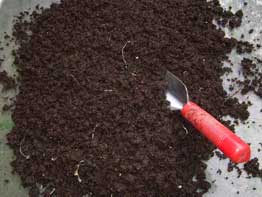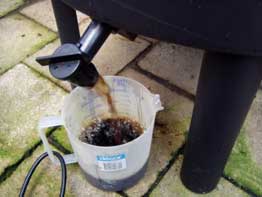WHERE CAN I OBTAIN COMPOST WORMS?
Most retailers of the Can-O-WormsTM bin also sell worms. Some, like the '4 Acres' Worm Farm, offer the Can-O-WormsTM.
HOW MUCH WILL MY WORMS EAT?
This depends on how many worms you have. Worms can eat up to half their own body weight every day and can double their population every few months. If you start your Can-O-WormsTM with 1kg. of mature worms. Under ideal conditions 1kg. of worms will consume approximately 5kgs. of paper and food waste per week. (identify mature worms by a distinct ring shaped swelling around their body) they will consume up to half a pound of food waste per day. After a few months you should have double your population and you can feed them more. The baby worms, however, won't eat much and will take about 3 months to mature. As you become familiar with them you will learn their rate of food consumption.
HOW CAN I HELP THE WORMS TO EAT MORE?
Worms will feed at a faster rate once they have adapted to any new food source. Worms will also eat more if food waste is cut into small pieces, mashed or processed. Controlling temperatures to around 70 degrees F (24 degrees C) will improve the overall performance of your system. Worms will leave very acidic food such as onions and orange peels until after they have eaten their preferred foods. A handful of garden lime (or crushed eggshells, oyster shells, or ashes from a fire) every few weeks will help to balance the effect of acidic foods. The regular addition of worm fattener (the recipe includes agricultural lime and is included in the Can-O-WormsTM instruction booklet) will encourage stronger, fatter worms. Since they consume up to half their own body weight each day, the fatter they are the more wastes they will eat.
WHAT SHOULDN'T I FEED MY WORMS?
Be careful what you feed your worms, particularly if you are unaware of it's source. Manures , for example, from horses, cattle or dogs often have vermicides still active in it that were designed to kill parasitic worms in the animal. They can kill all your worms in one day. If you use animal manures make sure you know when worming is conducted and avoid using the manure for a few weeks. Stay away from meat and meat by products.
CAN I FEED MY WORMS GARDEN REFUSE?
Not usually. The Can-O-WormsTM is designed to break down soft organic waste. Slow composting organic wastes, such as garden refuse are best dealt with by conventional aerobic composting methods. After conventionally composting, the worms will convert the material to worm castings and vermicompost for you.
I'VE HAD MY CAN-O-WORMSTM FOR A MONTH NOW, BUT THE WORMS DON'T SEEM TO BE EATING?
The worms may be eating your bedding material if you have used manure or compost in addition to your Can-O-WormsTM bedding block. If that is the case the worms will eat through this before eating any introduced food. If just the bedding block is used, the worms should readily eat introduced food waste, even though they do also like to eat the coir fiber.
SHOULD I ADD WATER TO THE CAN-O-WORMStm?
Do not pour water through the Can-O-WormsTM system. Food wastes are about 80% water, which is released as the worms break them down. This will tend to stay in the bedding for a long time before eventually draining out. Any dry material such as old manure, newspaper or cardboard should be presoaked before being added. It is important to keep moist newspaper or a moist burlap/hessian bag over the freshly added food to encourage the worms to move up to the surface to feed. This will provide a dark damp shelter for them. We recommend that you leave the tap in the open position with a bucket underneath so you can catch the castings "tea" as it develops and not risk making a bathtub in the collector tray for your worms. To make more worm tea, take one cup of castings from the lowest working tray and soak in a gallon of water overnight. The next day shake this liquid to aerate and use within 24 hours.
WILL I GET TOO MANY WORMS?
No, you can never have too many worms. They will regulate their population to the confines of available space and the amount of food you give them. Worm concentration should reach capacity (about 15,000 to 20,000 worms) after 2 - 5 years.
CAN I PUT COMPOST WORMS IN THE GARDEN?
Only if you have a thick surface layer of mulch in your garden. Compost worms require moist conditions all year round because they don't tunnel deep like the "earthworker worms" (Nightcrawlers) to find moisture. If you cannot provide this environment in your garden, don't introduce compost worms into it.
WHY AREN'T THE WORMS MOVING UP FROM THE LOWER LEVELS INTO THE TOP WORKING TRAY?
This situation can arise in two ways. First, you may be adding new food too soon before the worms can eat the previous food. This will result in a lot of uneaten wastes being distributed throughout the system and general reluctance by the worms to migrate upwards while they can still access material lower in the system. BEFORE ADDING NEW TRAYS, STOP FEEDING THE WORMS FOR AT LEAST A WEEK TO ENSURE THAT ALL EXISTING FOOD IN THE LOWER TRAY HAS BEEN EATEN. Worms will then move up to eat from the surface as this is their natural behavior pattern. Secondly, you may not have waited for the level of worm casting to pass the support ribs on the inside of the tray before adding the next tray. This will create a gap preventing the worms from reaching the top trays.
WHAT ABOUT SEVERE TEMPERATURES?
Worms will tolerate a wide temperature range from about 50 - 90 degrees F (10 -30 degrees C). If it gets much hotter than this, make sure the Can-O-WormsTM system is in a shady cool position. Take the lid off and hose the whole unit down keeping the bottom drainage tap turned on so it doesn't flood. If it gets much colder and freezes, put your Can-O-WormsTM in the warmest possible position, an example being your basement, laundry or shed. If it is on a balcony or in the yard, cover the unit with a couple of old carpet pads or old blankets to keep some warmth in. Feed them a lot more food wastes which will create some warmth as the food decomposes. The best place to have your Can-O-WormsTM is indoors, where the temperature always stays the same.
IT'S RAINING AND THE WORMS SEEM TO BE GATHERING IN THE LID. WHAT DO I DO?
What you are noticing is the worms sensitivity to pressure changes in the weather. They will often go up into the lid even before it rains. In nature this takes them out of the soil to stop them from flooding and drowning. Move the Can-O-WormsTM out of the rain. Take the worms out of the lid and replace them in the bedding if needed.
HOW DO I KEEP ANTS OUT OF MY CAN-O-WORMStm?
Ants may enter your Can-O-WormsTM if you have a lot of them in your yard and particularly if you have let the bedding become too dry or acidic. Add water to raise the moisture level and add a liberal quantity of garden lime or crushed eggshells to where the ants are gathering. This should discourage them. If they persist, remove them physically and smear some vaseline around the legs or place each leg of the Can-O-WormsTM in a container of water to isolate the system. An ant trap temporarily placed in the bin will also help in keeping the ants away.
WILL THE CAN-O-WORMStm ATTRACT FLIES?
No, the Can-O-WormsTM is fly-proof against household flies. Sometimes the very small vinegar fly (often mistaken for the fruit fly) gets in, but these do not harm. However, very large numbers of the vinegar fly may indicate that you are feeding your Can-O-WormsTM too much and may be a prelude to problems such as offensive odors. To eradicate vinegar flies, slow your rate of feeding to what the worms will eat on a daily basis and ensure that freshly added wastes are covered by a moist newspaper or burlap bag.
WILL THE CAN-O-WORMStm SMELL?
The only smell associated with a well maintained Can-O-WormsTM system is a pleasant rainforest odor. If your Can-O-WormsTM has an offensive smell, it is an indication that anaerobic bacteria have built up in the system in uneaten food wastes. Stop feeding the worms and stir the wastes in the tip tray lightly with a garden fork , adding garden lime as well. This aerates the organic material and allows worms to move through it more easily. Repeat this aeration procedure regularly to prevent recurrence. Start feeding again when all smells are gone.
WHAT ABOUT HOLIDAYS?
Leaving an established Can-O-WormsTM for 3-4 weeks without constantly adding food is not a problem. Just feed the worms a good quantity of food waste (1/3 of a tray full) before your leave. Make sure that you leave the unit in a cool place under cover and leave the tap open with a container under it. Putting a soaked newspaper on top of your burlap will give added protection against their bedding drying out.
AS A GUIDE, WORMS WILL EAT ANYTHING THAT WAS ONCE LIVING
This includes: Left over vegetable scraps, fruit and vegetable peelings Manure (well aged) Tea leaves/bags and coffee filters and grounds Vacuum cleaner dust Hair and nail clippings (also pet) Torn up newspapers, egg and pizza cartons (soaked first) Shredded cardboard (soaked first) Crushed egg shells (these will help with the pH balance) Compost The greater the variety of material you use, the better the casting will be!!
WHERE CAN I BUY THE CAN-O-WORMStm?
There are many people selling the Can-O-WormsTM but the best price is probably at The '4 Acres' Worm Farm. Not only is the Can-O-WormsTM bin inexpensive from the nice folks at the '4 Acres" worm farm, but they also have super package deals which include the Can-O-WormsTM system, worms, and educational books for a super low price!
DO NOT OVERFEED!!
Over-feeding encourages earthworm enemies. Worms like a neutral situation, most insects prefer acid conditions.
Centipedes are vicious and can take a heavy toll of young worms, remove and check Ph. Nemotode worms can be mistaken for baby worms. They do no harm but indicate an acid condition and the addition of lime will correct this
Worms should be fed often and in small quantities, and it is better to feed lightly every couple of days, than to feed a huge quantity once every ten days. Good bedding can be any combination of aged manures, shredded paper products, coir (coconut fiber), decomposing leaves, straw, wood chips, peat moss.
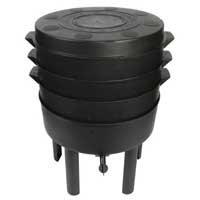 The Can-O-Worms is an odourless, user friendly system that allows anyone to participate in recycling. Whether you live in an apartment or have a backyard, you can provide organic fertiliser for indoor plants and your garden. For keen fishermen the unit will breed up to 20,000 bait worms which are easily removed from the top!
The Can-O-Worms is an odourless, user friendly system that allows anyone to participate in recycling. Whether you live in an apartment or have a backyard, you can provide organic fertiliser for indoor plants and your garden. For keen fishermen the unit will breed up to 20,000 bait worms which are easily removed from the top!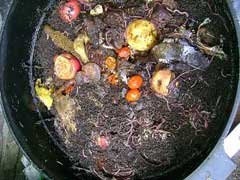 This exciting new composting system is the result of years of research and development, to utilize the benefits of worms which are nature’s own recyclers. By putting worms to work in this innovative system you will be converting your food waste into nutrient rich, 100% organic fertilizer that your potted plants, garden and vegetables will love.
This exciting new composting system is the result of years of research and development, to utilize the benefits of worms which are nature’s own recyclers. By putting worms to work in this innovative system you will be converting your food waste into nutrient rich, 100% organic fertilizer that your potted plants, garden and vegetables will love.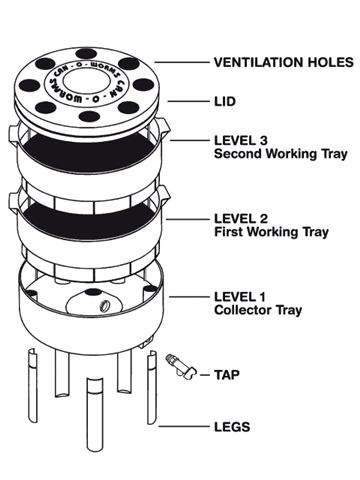 The Can-O-Worms is fly and pest proof and stands on five sturdy legs. It is fun and educational exercise the whole family can participate in.
The Can-O-Worms is fly and pest proof and stands on five sturdy legs. It is fun and educational exercise the whole family can participate in.
